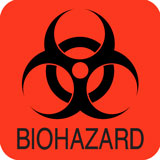Biohazardous and Medical Waste
Proper biohazardous waste treatment procedures will ensure consistent sterilization, personal protection, and experimental integrity. Your cooperation is required for regulatory compliance, and for an effective biohazardous waste management program.
Biohazardous Waste Includes, But Is Not Limited To
- Cell cultures and stocks
- Culture dishes
- Devices used with cultures
- Waste derived from the production of biological agents
- Animals or human surgical specimens
- Animal or human blood or body fluids
- Used sharps, contaminated animal carcasses, body parts, excrement and bedding
- Genetically modified plants
For additional information on biohazardous waste or biological safety, please refer to UCSD Biosafety Program overview.
Review the Biohazardous Waste Disposal Guidelines for Liquid Waste.
- All liquid biohazardous waste must be sterilized using bleach or other approved liquid disinfectant. The final concentration of liquid biohazardous waste to bleach should be 10:1 or 10% bleach.
- Allow the 10% bleached waste solution to sit for 30 minutes prior to drain disposal.
- Under stringent, approved circumstances that require disinfection of liquid biohazardous waste using an autoclave in lieu of chemical decontamination, please contact the Division Safety Office to make alternative arrangements.
Review the Biohazardous Waste Disposal Guidelines for Solid Waste
- Appropriate Container
- Collect dry biohazardous waste in double red biohazard waste bags within a rigid, leak-proof, labelled container that uses a tight-fitting lid. Bags must have ASTM markings for ASTM D1922 and ASTM D1709.
- Marketplace, the Chemistry & Biochemistry Stockroom, and Core Bio Services sell bags pre-printed with UCSD identification labels in various sizes and quantities.

- Proper Labeling
- Ensure that all rigid containers have the proper biohazard symbol (see above) attached for accessibility and identification.
- Label the outer container and both red bags with UCSD identification and generator information prior to any addition of waste:
University of California, San Diego
9500 Gilman Drive, La Jolla, CA 92093
858-534-3660, 858-534-4357
[Building], [Room #]
- Collection Tips
- Do not place any free liquids, such as full conicals or tubes, into red bags. Such items must be clean/empty per the California RCA "empty" standard.
- Leave enough room to tie the inner-most bag, followed by the outer-most bag with a secure knot or zip-tie. Red bags must be fully secured and contained waste should not be exposed.
- If all red "collection bins" in the buidling are full, email HAZWASTE@ucsd.edu to request an emergency pickup.
- Disposal Steps
- Place the full, secured red bags in your building's designated biohazardous waste collection area (e.g. autoclave rooms) for biweekly removal by campus EMF. Waste should stored in grey biohazard collection bins with tightly sealed lids.
- If red collection bins are full, do not store surplus red bags on top or adjacent to bins. Instead, contact campus EMF (hazwaste@ucsd.edu or 858-534-2753) to arrange pick-up and, if necessary, drop off additional red container bins to meet demand.
- Biohazardous Waste Collection Areas:
- AP&M, Biology Field Station, Bonner Hall, CNCB, Muir Biology, NSB, Pacific Hall, York Hall - Autoclave Rooms/Spaces
- Tata Hall - 2nd Floor Loading Dock (the combination for the caged bin-accumulation space can be obtained from your lab manager or from the Division Safety Office).
- For disposal of animal carcasses, please follow the Animal Carcass Disposal Pathway flowchart
Please visit the Biohazardous and Medical Waste Overview for campus policies concerning biohazardous waste disposal for solids.
Review the Biohazardous Waste Disposal Guidelines for Sharps Waste.
- Label the red, biohazardous sharps container with UCSD identification and generator information prior to any addition of waste:
-
University of California, San Diego
9500 Gilman Drive, La Jolla, CA 92093
858-534-3660, 858-534-4357
[Building], [Room #]
- Collection Tips
- Do not place free liquids, such as full syringes, in sharps containers. Disposed sharps cannot extend above the "FILL" line.
- When full, engaged the auto-locking lid and begin a new (labelled) red sharps waste container. Do not attempt to re-open or re-use a previously locked container.
- Disposal Steps
- Place the full, locked sharps container in your building's designated biohazardous waste collection area (e.g. autoclave rooms) for biweekly removal by campus EMF. Sharps containers, along with solid biohazardous waste in double red bags, should be stored in grey biohazard collection bins with tightly sealed lids.
- Biohazardous Waste Collection Areas:
- AP&M, Biology Field Station, Bonner Hall, CNCB, Muir Biology, NSB, Pacific Hall, York Hall - Autoclave Rooms/Spaces
- Tata Hall - 2nd Floor Loading Dock& (the combination for the caged bin-accumulation space can be obtained from your lab manager or from the Division Safety Office).
- For disposal of animal carcasses please follow the Animal Carcass Disposal Pathway flowchart.
Please visit the Biohazardous and Medical Waste Overview for campus policies concerning biohazardous waste disposal for sharps.
- Disposal of biohazardous waste within the grey collection bins (and subsequent pick-up by campus EMF) is the standard process for all campus laboratories.
- Autoclaving biohazardous waste is restricted to those who have received an exception and additional training and who have signed a statement acknowledging receipt of training. Dedicated USDA/APHIS approved autoclaves or an autoclave with a county permit for medical waste must be used.
If you have any questions or concerns, contact safetyofficer@biology.ucsd.edu at 858-333-9791
Autoclaving Guidelines for Biohazardous Waste on Blink.
